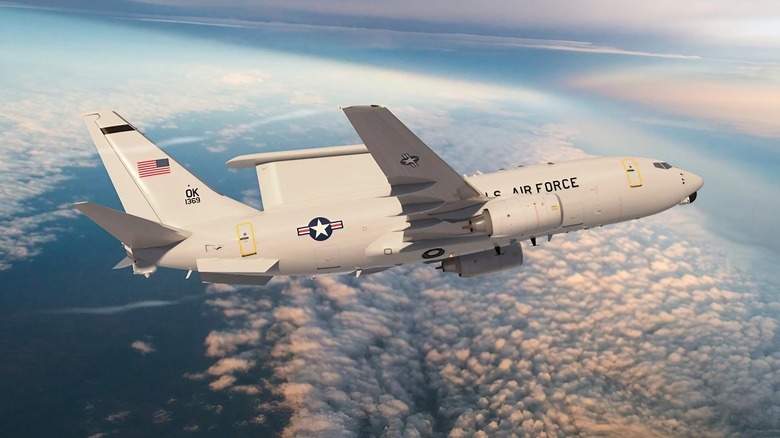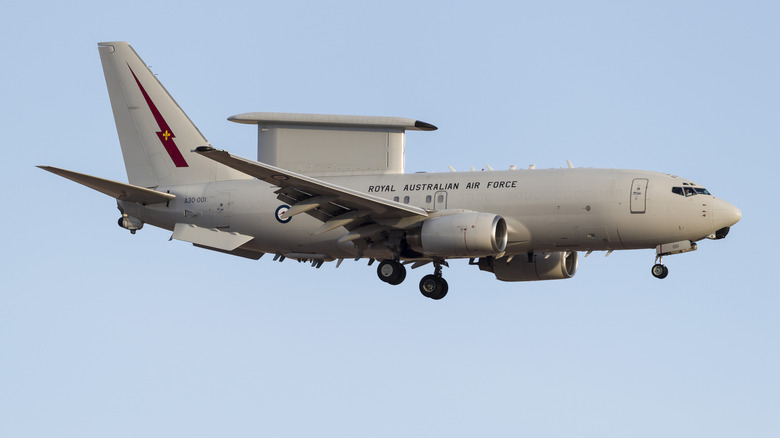Why The US Military Is Canceling The Next-Gen E-7 Wedgetail (And What Does It Mean For Boeing?)
The Air Force's much-anticipated E-7 Wedgetail program was axed in June. This aircraft, based on the Boeing 737, is a flying command center whose primary role is to serve as an AWACS (Airborne Warning and Control System). Its powerful systems allow it to scan vast areas, detecting and tracking hostile aircraft and missiles — a function the Pentagon refers to as the Air Moving Target Indicator (AMTI) mission. The plan was to replace the military's creaky, old E-3 Sentry AWACS fleet with 26 new Wedgetails. The plane looked like a sure thing, too, at least on paper. Already flown by key U.S. allies, it boasts a powerful Northrop Grumman MESA radar that can track targets on the sea and in the air simultaneously.
The news didn't come as a total surprise, as rumors had been circulating about the Trump administration considering cancellation. The main issue is that a dedicated aircraft platform has limited coverage. The military wants to expand its monitoring to cover the entire planet, a task that a fleet of aircraft alone cannot handle. So, as part of the FY26 bill introduced by the Trump administration, senior military officials argued that the Wedgetail is just "not survivable" – especially in a future fight against a sophisticated enemy like China. Costs were also spiraling, with the price tag for the aircraft reportedly jumping from $588 million to $724 million.
Instead of performing the AMTI mission from the air, officials are now pivoting to space. They believe that satellite constellations can handle this job more effectively and provide the needed global coverage. They also think that such a solution can be delivered faster than the E-7. Still, this abrupt pivot has undoubtedly left a capability gap and would force the aging E-3s to be used for even longer.
What does it mean for Boeing?
The cancellation is yet another black eye for Boeing's struggling defense division. Defence Blog reports that the company has been hemorrhaging cash on a series of ambitious, fixed-price development contracts, a strategy that has spectacularly backfired. For instance, in 2022, Boeing Defense recorded a staggering $4.4 billion charge, with losses continuing into the following year.
Moreover, the E-7 only joins a growing list of troubled programs. The KC-46A Pegasus tanker has been a financial disaster, racking up roughly $7 billion in losses as of 2023 due to persistent design flaws, like its faulty Remote Vision System. The T-7A Red Hawk trainer is also at least two years behind schedule and has cost Boeing about $1.3 billion in losses. Even the high-profile Air Force One replacement is years late and has already gone $2 billion+ over budget. These failures share a common theme. Boeing underestimated the complexity of these projects and got locked into contracts where it had to eat the cost of overruns. Ultimately, such setbacks could reinforce the narrative of a defense giant that can't seem to deliver.
What lies ahead
To plug the gap left by the E-7's cancellation, the Pentagon is turning to Northrop Grumman's E-2D Hawkeye. The budget proposes $150 million in FY26 to stand up a joint expeditionary unit with five dedicated E-2Ds. An additional $1.4 billion is allocated to procure more Hawkeyes as a near-term solution. While the E-2D is smaller and has less range than the E-7, its ability to operate from forward bases is seen as a big advantage for future combat operations.
Of course, the FY26 budget proposal goes far beyond the E-7. The Air Force is looking to send a whopping 340 aircraft to the boneyard, freeing up cash for next-gen priorities. Perhaps the most controversial move is the plan to retire the entire remaining fleet of 162 A-10 Warthogs in one go. This decision is likely to spark a fight with Congress. Also on the chopping block are dozens of other jets, including 13 F-15 C/Ds, 21 F-15Es, and 62 F-16C/Ds.


